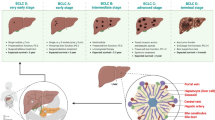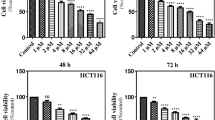Abstract
Resveratrol (RSV) is a natural polyphenol that is known as a powerful chemopreventive and chemotherapeutic anticancer molecule. This study focused on the effects of RSV on the activities and expression levels of antioxidant enzymes in the cancer cells. Prostate cancer PC-3 cells, hepatic cancer HepG2 cells, breast cancer MCF-7 cells and the non-cancerous HEK293T kidney epithelial cells were treated with a wide range of RSV concentrations (10-100 μM) for 24–72 h. Cell growth was estimated by trypan blue staining, activities of the antioxidant enzymes were measured spectrophotometrically, expression levels of the antioxidant enzymes were quantified by digitalizing the protein band intensities on Western blots, and the percentage of apoptotic cells was determined by flow cytometry. Treatment with a low concentration of RSV (25 μM) significantly increased superoxide dismutase (SOD) activity in PC-3, HepG2 and MCF-7 cells, but not in HEK293T cells. Catalase (CAT) activity was increased in HepG2 cells, but no effect was found on glutathione peroxidase (GPX) upon RSV treatment. RSV-induced SOD2 expression was observed in cancer cells, although the expression of SOD1, CAT and GPX1 was unaffected. Apoptosis increased upon RSV treatment of cancer cells, especially in PC-3 and HepG2 cells. Together, our data demonstrated that RSV inhibits cancer cell growth with minimal effects on non-cancerous cells. We postulate that the disproportional up-regulation of SOD, CAT and GPX expression and enzymatic activity in cancer cells results in the mitochondrial accumulation of H2O2, which in turn induces cancer cell apoptosis.
Similar content being viewed by others
References
Arsova-Sarafinovska, Z., Eken, A., Matevska, N., Erdem, O., Sayal, A., Savaser, A., Banev, S., Petrovski, D., Dzikova, S., Georgiev, V., et al. (2009). Increased oxidative/nitrosative stress and decreased antioxidant enzyme activities in prostate cancer. Clin. Biochem. 42, 1228–1235.
Bae, S., Lee, E.M., Cha, H.J., Kim, K., Yoon, Y., Lee, H., Kim, J., Kim, Y.J., Lee, H.G., Jeung, H.K., et al. (2011). Resveratrol alters microRNA expression profiles in A549 human non-small cell lung cancer cells. Mol. Cells 32, 243–249.
Benitez, D.A., Pozo-Guisado, E., Alvarez-Barrientos, A., Fernandez-Salguero, P.M., and Castellón, E.A. (2007). Mechanisms involved in resveratrol-induced apoptosis and cell cycle arrest in prostate cancer-derived cell lines. J. Androl. 28, 282–293.
Bishayee, A. (2009). Cancer prevention and treatment with resveratrol: from rodent studies to clinical trials. Cancer Prev. Res. (Phila) 2, 409–418.
Bradford, M.M. (1976). A rapid and sensitive method for the quantitation of microgram quantities of protein utilizing the principle of protein-dye binding. Anal. Biochem. 72, 248–254.
Carbó, N., Costelli, P., Baccino, F.M., López-Soriano, F.J., and Argilés, J.M. (1999). Resveratrol, a natural product present in wine, decreases tumour growth in a rat tumour model. Biochem. Biophys. Res. Commun. 254, 739–743.
Chen, Y., Tseng, S.H., Lai, H.S., and Chen, W.J. (2004). Resveratrol-induced cellular apoptosis and cell cycle arrest in neuroblastoma cells and antitumor effects on neuroblastoma in mice. Surgery 136, 57–66.
Chung-man Ho, J., Zheng, S., Comhair, S.A., Farver, C., and Erzurum, S.C. (2001). Differential expression of manganese superoxide dismutase and catalase in lung cancer. Cancer Res. 61, 8578–8585.
De Craemer, D., Pauwels, M., Hautekeete, M., and Roels, F. (1993). Alterations of hepatocellular peroxisomes in patients with cancer. Catalase cytochemistry and morphometry. Cancer 71, 3851–3858.
Elchuri, S., Oberley, T.D., Qi, W., Eisenstein, R.S., Jackson Roberts, L., Van Remmen, H., Epstein, C.J., and Huang, T.T. (2005). CuZnSOD deficiency leads to persistent and widespread oxidative damage and hepatocarcinogenesis later in life. Oncogene 24, 367–380.
Frémont, L., Belguendouz, L., and Delpal, S. (1999). Antioxidant activity of resveratrol and alcohol-free wine polyphenols related to LDL oxidation and polyunsaturated fatty acids. Life Sci. 64, 2511–2521.
Giorgio, M., Migliaccio, E., Orsini, F., Paolucci, D., Moroni, M., Contursi, C., Pelliccia, G., Luzi, L., Minucci, S., Marcaccio, M., et al. (2005). Electron transfer between cytochrome c and p66Shc generates reactive oxygen species that trigger mitochondrial apoptosis. Cell 122, 221–233.
Giorgio, M., Trinei, M., Migliaccio, E., and Pelicci, P.G. (2007). Hydrogen peroxide: a metabolic by-product or a common mediator of ageing signals? Nat. Rev. Mol. Cell Biol. 8, 722–728.
Góth, L. (1991). A simple method for determination of serum catalase activity and revision of reference range. Clin. Chim. Acta 196, 143–151.
Graf, E., and Penniston, J.T. (1980). Method for determination of hydrogen peroxide, with its application illustrated by glucose assay. Clin. Chem. 26, 658–660.
Harikumar, K.B., and Aggarwal, B.B. (2008). Resveratrol: a multitargeted agent for age-associated chronic diseases. Cell Cycle 7, 1020–1035.
Huang, X., and Zhu, H.L. (2011). Resveratrol and its analogues: promising antitumor agents. Anticancer Agents Med. Chem. 11, 479–490.
Jang, M., Cai, L., Udeani, G.O., Slowing, K.V., Thomas, C.F., Beecher, C.W., Fong, H.H., Farnsworth, N.R., Kinghorn, A.D., Mehta, R.G., et al. (1997). Cancer chemopreventive activity of resveratrol, a natural product derived from grapes. Science 275, 218–220.
Jeon, S.H., Jae-Hoon Park, J.H., and Chang, S.G. (2007). Expression of antioxidant enzymes (catalase, superoxide dis-mutase, and glutathione peroxidase) in human bladder cancer. Korean J. Urol. 48, 921–926.
Kasapović, J., Pejić, S., Todorović, A., Stojiljković, V., and Pajović, S.B. (2008). Antioxidant status and lipid peroxidation in the blood of breast cancer patients of different ages. Cell Biochem. Funct. 26, 723–730.
Khan, M.A., Tania, M., Zhang, D.Z., and Chen, H.C. (2010). Antioxidant enzymes and cancer. Chin. J. Cancer Res. 22, 87–92.
Klaunig, J.E., and Kamendulis, L.M. (2004). The role of oxidative stress in carcinogenesis. Annu. Rev. Pharmacol. Toxicol. 44, 239–267.
Kovacic, P., and Somanathan, R. (2010). Multifaceted approach to resveratrol bioactivity: focus on antioxidant action, cell signaling and safety. Oxid. Med. Cell Longev. 3, 86–100.
Kowaltowski, A.J., Castilho, R.F., and Vercesi, A.E. (2001). Mitochondrial permeability transition and oxidative stress. FEBS Lett. 495, 12–15.
Miller, N.J., and Rice-Evans, C.A. (1995). Antioxidant activity of resveratrol in red wine. Clin. Chem. 41, 1789.
Mo, W., Xu, X., Xu, L., Wang, F., Ke, A., Wang, X., and Guo, C. (2012). Resveratrol inhibits proliferation and induces apoptosis through the hedgehog signaling pathway in pancreatic cancer cell. Pancreatology 11, 601–609.
Muqbil, I., Beck, F.W., Bao, B., Sarkar, F.H., Mohammad, R.M., Hadi, S.M., and Azmi, A.S. (2012). Old wine in a new bottle: the Warburg effect and anticancer mechanisms of resveratrol. Curr. Pharm. Des. 18, 1645–1654.
Nakata, R., Takahashi, S., and Inoue, H. (2012). Recent advances in the study on resveratrol. Biol. Pharm. Bull. 35, 273–279.
Park, C.E., Yun, H., Lee, E.B., Min, B.I., Bae, H., Choe, W., Kang, I., Kim, S.S., and Ha, J. (2010). The antioxidant effects of genistein are associated with AMP-activated protein kinase activation and PTEN induction in prostate cancer cells. J. Med. Food 13, 815–820.
Park, S.J., Ahmad, F., Philp, A., Baar, K., Williams, T., Luo, H., Ke, H., Rehmann, H., Taussig, R., Brown, A.L., et al. (2012). Resveratrol ameliorates aging-related metabolic phenotypes by inhibiting cAMP phosphodiesterases. Cell 148, 421–433.
Patel, K.R., Scott, E., Brown, V.A., Gescher, A.J., Steward, W.P., and Brown, K. (2011). Clinical trials of resveratrol. Ann. N. Y. Acad. Sci. 1215, 161–169.
Petit, E., Courtin, A., Kloosterboer, H.J., Rostène, W., Forgez, P., and Gompel, A. (2009). Progestins induce catalase activities in breast cancer cells through PRB isoform: correlation with cell growth inhibition. J. Steroid Biochem. Mol. Biol. 115, 153–160.
Robb, E.L., Page, M.M., Wiens, B.E., and Stuart, J.A. (2008). Molecular mechanisms of oxidative stress resistance induced by resveratrol: Specific and progressive induction of MnSOD. Biochem. Biophys. Res. Commun. 367, 406–412.
Rotruck, J.T., Pope, A.L., Ganther, H.E., Swanson, A.B., Hafeman, D.G., and Hoekstra, W.G. (1973). Selenium: biochemical role as a component of glutathione peroxidase. Science 179, 588–590.
Scarlatti, F., Maffei, R., Beau, I., Codogno, P., and Ghidoni, R. (2008). Role of non-canonical Beclin 1-independent autophagy in cell death induced by resveratrol in human breast cancer cells. Cell Death Differ. 15, 1318–1329.
Scott, E., Steward, W.P., Gescher, A.J., and Brown, K. (2012). Resveratrol in human cancer chemoprevention—choosing the ‘right’ dose. Mol. Nutr. Food Res. 56, 7–13.
Sengottuvelan, M., Deeptha, K., and Nalini, N. (2009). Resveratrol ameliorates DNA damage, prooxidant and antioxidant imbalance in 1,2-dimethylhydrazine induced rat colon carcinogenesis. Chem. Biol. Interact. 181, 193–201.
Sharma, A., Tripathi, M., Satyam, A., and Kumar, L. (2009). Study of antioxidant levels in patients with multiple myeloma. Leuk. Lymphoma 50, 809–815.
Sun, Y.I., Oberley, L.W., and Li, Y. (1988). A simple method for clinical assay of superoxide dismutase. Clin. Chem. 34, 497–500.
Yu, J., and Kim, A.K. (2009). Effect of taurine on antioxidant enzyme system in B16F10 melanoma cells. Adv. Exp. Med. Biol. 643, 491–499.
Zhou, H.B., Chen, J.J., Wang, W.X., Cai, J.T., and Du, Q. (2005). Anticancer activity of resveratrol on implanted human primary gastric carcinoma cells in nude mice. World J. Gastroenterol. 11, 280–284.
Author information
Authors and Affiliations
Corresponding author
About this article
Cite this article
Khan, M.A., Chen, Hc., Wan, Xx. et al. Regulatory effects of resveratrol on antioxidant enzymes: A mechanism of growth inhibition and apoptosis induction in cancer cells. Mol Cells 35, 219–225 (2013). https://doi.org/10.1007/s10059-013-2259-z
Received:
Revised:
Accepted:
Published:
Issue Date:
DOI: https://doi.org/10.1007/s10059-013-2259-z




